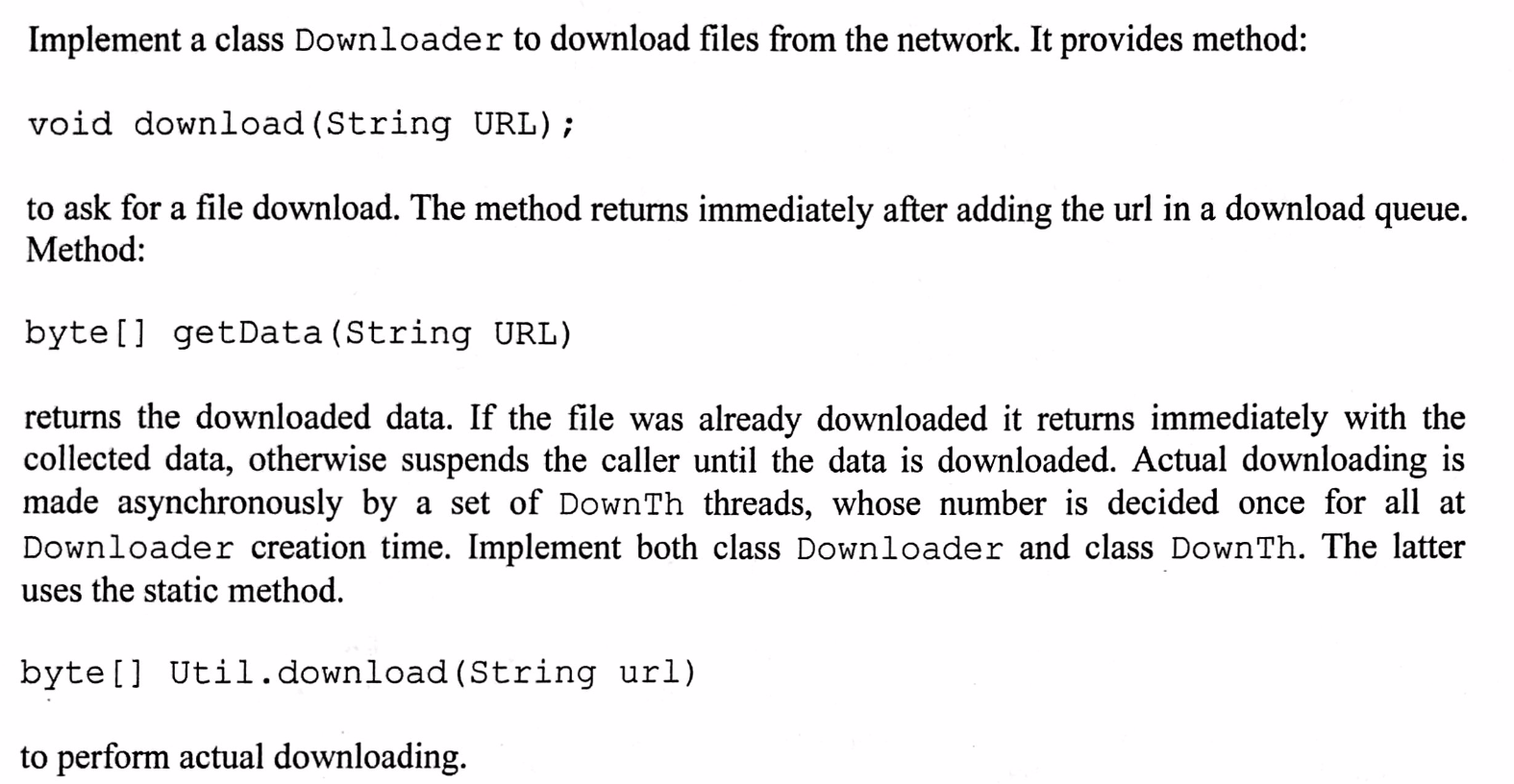Java并发性练习。异步下载
Java并发性练习。异步下载
提问于 2017-07-17 09:29:01
我正在做一个关于Java并发性的练习,使用等待、通知来为考试做准备。考试将是书面的,所以代码必须是完美的,因为我们不能试图编译和检查错误。
这是这项工作的案文:

一般想法:
- 在安装下载程序时,将创建队列和散列映射,并将其传递给所有线程。(共享数据)
- 下载方法将url添加到队列中,并调用notifyAll来唤醒Downloader。
- getData方法等待到提供的url的hashmap中有数据。当数据可用时,它将返回给调用方。
- 下装载机线程运行无穷大循环。它等待到队列中有一个url。当它收到一个url时,它会下载它,并将字节放在hashmap中,调用notifyAll来唤醒可能在getData方法中等待的用户。
这是我编写的代码:
public class Downloader{
private Queue downloadQueue;
private HashMap urlData;
private final static THREADS_NUMBER;
public Downloader(){
this.downloadQueue = new Queue();
this.urlData = new HashMap();
for(int i = 0; i < THREADS_NUMBER; i++){
new DownTh(this.downloadQueue, this.urlData).start();
}
}
void syncronized download(String URL){
downloadQueue.add(url);
notifyAll();
return;
}
byte[] syncronized getData(String URL){
while(urlData.get(URL) == null ){
wait()
}
return urlData.get(URL);
}
}
public class DownTh extend Thread{
private Queue downloadQueue;
private HashMap urlData;
public DownTh(Queue downloadQueue, HashMap urlData){
this.downloadQueue = downloadQueue
this.urlData = urlData;
}
public void run(){
while(true){
syncronized{
while(queue.isEmpty()){
wait()
}
String url = queue.remove();
urlData.add(url, Util.download(url))
notifyAll()
}
}
}
}你能帮我,告诉我逻辑是否正确吗?
回答 1
Stack Overflow用户
回答已采纳
发布于 2017-07-17 11:48:06
让我们先假设Java中所有处理同步的伟大类都不存在,因为这是一个合成任务,您需要处理的只有sychronized、wait和notify。
用简单的话回答的第一个问题是:“谁会等待什么?”
- 下载线程将等待一个URL下载。
- 调用者将等待下载线程的结果。
这究竟意味着什么呢?我们需要调用方和下载线程(您的urlData)之间至少有一个同步元素,也应该有一个数据对象处理下载数据本身,以便方便,并检查下载是否已经完成。
因此,将要发生的详细步骤是:
- 来电者请求新下载。 创建: DownloadResult 写: urlData(url -> DownloadResult) 唤醒urlData上的一个线程。
- 线程X必须找到数据才能下载和处理,否则就会再次入睡。 read: urlData (查找第一个未处理的DownloadResult,否则等待urlData) 写: DownloadResult (获取它) 写: DownloadResult (下载结果) 通知:任何等待DownloadResult的人 重复
- 调用方必须能够异步检查/等待下载结果。 读: urlData 阅读: DownloadResult (如有需要,请等待DownloadResult )
由于在这些对象上有来自不同线程的读写,所以在访问对象urlData或DownloadResult时需要同步。
此外,还将出现等待/通知关联:
- 呼叫者-> urlData -> DownTh
- DownTh -> DownloadResult ->调用者
在仔细分析之后,以下代码将满足这些要求:
public class DownloadResult {
protected final URL url; // this is for convenience
protected boolean inProgress;
protected byte[] result;
public DownloadResult(final URL url) {
this.url = url;
this.inProgress = false;
}
/* Try to lock this against tother threads if not already acquired. */
public synchronized boolean acquire() {
if (this.inProgress == false) {
this.inProgress = true;
return true;
} else {
return false;
}
}
public void download() {
final byte[] downloadedBytes = Util.download(this.url); // note how this is done outside the synchronized block to avoid unnecessarily long blockings
synchronized (this) {
this.result = downloadedBytes;
this.notifyAll(); // wake-up ALL callers
}
}
public synchronized byte[] getResult() throws InterruptedException {
while (this.result == null) {
this.wait();
}
return this.result;
}
}
protected class DownTh extends Thread {
protected final Map<URL, DownloadResult> urlData;
public DownTh(final Map<URL, DownloadResult> urlData) {
this.urlData = urlData;
this.setDaemon(true); // this allows the JVM to shut down despite DownTh threads still running
}
protected DownloadResult getTask() {
for (final DownloadResult downloadResult : urlData.values()) {
if (downloadResult.acquire()) {
return downloadResult;
}
}
return null;
}
@Override
public void run() {
DownloadResult downloadResult;
try {
while (true) {
synchronized (urlData) {
while ((downloadResult = this.getTask()) == null) {
urlData.wait();
}
}
downloadResult.download();
}
} catch (InterruptedException ex) {
// can be ignored
} catch (Error e) {
// log here
}
}
}
public class Downloader {
protected final Map<URL, DownloadResult> urlData = new HashMap<>();
// insert constructor that creates the threads here
public DownloadResult download(final URL url) {
final DownloadResult result = new DownloadResult(url);
synchronized (urlData) {
urlData.putIfAbsent(url, result);
urlData.notify(); // only one thread needs to wake up
}
return result;
}
public byte[] getData(final URL url) throws InterruptedException {
DownloadResult result;
synchronized (urlData) {
result = urlData.get(url);
}
if (result != null) {
return result.getResult();
} else {
throw new IllegalStateException("URL " + url + " not requested.");
}
}
}在实际的Java中,通过使用并发类和/或原子.上课,所以这只是为了教育目的。如需进一步阅读,请参阅“可调用的未来”。
页面原文内容由Stack Overflow提供。腾讯云小微IT领域专用引擎提供翻译支持
原文链接:
https://stackoverflow.com/questions/45140516
复制相关文章
相似问题

